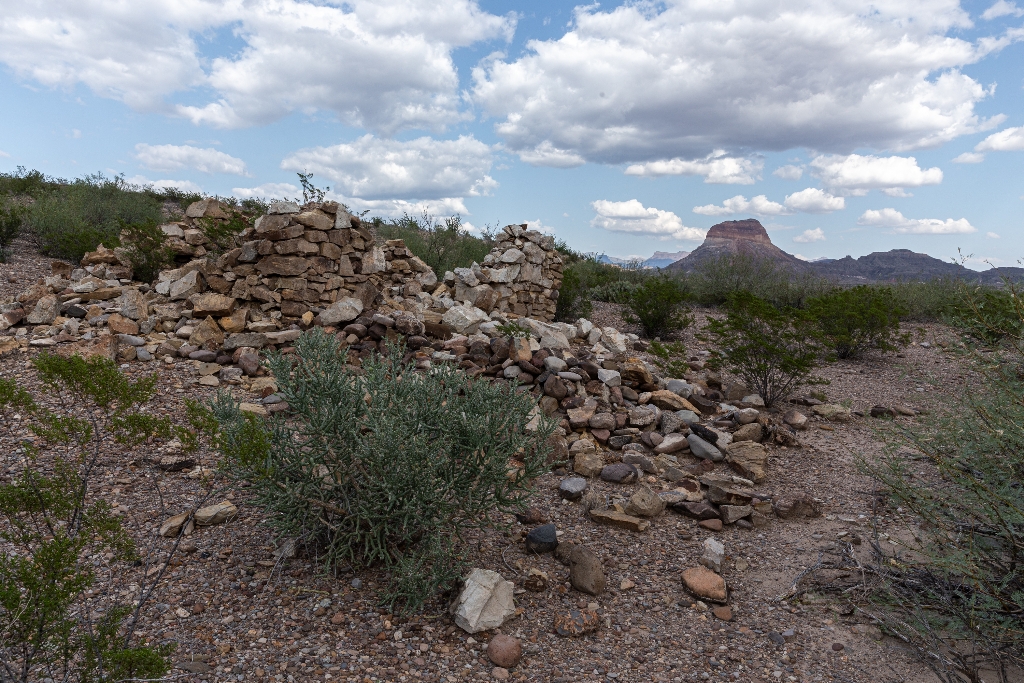
Near Alamo Creek, between mile marker 1 and 2, the road cuts through the ruins of La Coyota, the oldest documented community in Big Bend National Park. A few crumbling foundations are all that remain of the community, although La Coyota was once home to nearly a dozen Mexican and Mexican-American families. In 1884, Don Severiano Chavarria moved to this area with two sons and two daughters. His third daughter, Petra, was born the following year. His family eventually expanded to include eleven sons and five daughters, and as new families moved to the area, a community was born.
The family of Matilde and Theodora “Lola” Garcia also called La Coyota home. They built an adobe home and raised two boys and two girls. Mr. Garcia sometimes worked for his neighbor, Albert Dorgan, or as a cowboy for Cartledge’s ranching operation. He also worked for Homer Wilson on the Blue Creek Ranch at the base of the Chisos Mountains. In the winter, Garcia worked in the mercury mines at Terlingua, and his children attended school in Study Butte. Mrs. Garcia took care of the children, cows, goats, and chickens. The children helped at home and sometimes crated vegetables on Dorgan’s farm or rode horseback, helping their father with cattle roundups.
The families of La Coyota fared well with plenty of meat, fish, water, and vegetables. They also bought supplies at the La Harmonia Store or from stores in Study Butte and Terlingua. But life was not without its difficulties. Measles, rashes, stomach disorders, and fevers were common. The families cured many illnesses using traditional remedies from desert plants and herbs, but advanced medical care was far away. Many of the graves in the local cemeteries are those of children.
Please treat historic sites with respect. Remember that archeological and historical items are protected by law. Do not move or collect anything in the park.
The family of Matilde and Theodora “Lola” Garcia also called La Coyota home. They built an adobe home and raised two boys and two girls. Mr. Garcia sometimes worked for his neighbor, Albert Dorgan, or as a cowboy for Cartledge’s ranching operation. He also worked for Homer Wilson on the Blue Creek Ranch at the base of the Chisos Mountains. In the winter, Garcia worked in the mercury mines at Terlingua, and his children attended school in Study Butte. Mrs. Garcia took care of the children, cows, goats, and chickens. The children helped at home and sometimes crated vegetables on Dorgan’s farm or rode horseback, helping their father with cattle roundups.
The families of La Coyota fared well with plenty of meat, fish, water, and vegetables. They also bought supplies at the La Harmonia Store or from stores in Study Butte and Terlingua. But life was not without its difficulties. Measles, rashes, stomach disorders, and fevers were common. The families cured many illnesses using traditional remedies from desert plants and herbs, but advanced medical care was far away. Many of the graves in the local cemeteries are those of children.
Please treat historic sites with respect. Remember that archeological and historical items are protected by law. Do not move or collect anything in the park.
Is there something we missed for this itinerary?
Itineraries across USA

Acadia

Arches National Park

Badlands

Big Bend

Biscayne

Black Canyon Of The Gunnison

Bryce Canyon

Canyonlands

Capitol Reef

Carlsbad Caverns

Channel Islands

Congaree

Crater Lake

Cuyahoga Valley

Death Valley

Dry Tortugas

Everglades

Gateway Arch

Glacier

Grand Canyon

Grand Teton

Great Basin

Great Smoky Mountains

Guadalupe Mountains

Haleakalā

Hawaiʻi Volcanoes

Hot Springs

Indiana Dunes

Isle Royale

Joshua Tree

Kenai Fjords

Kobuk Valley

Lassen Volcanic

Mammoth Cave

Mesa Verde

Mount Rainier

North Cascades

Olympic

Petrified Forest

Pinnacles

Rocky Mountain

Saguaro

Shenandoah

Theodore Roosevelt

Virgin Islands

Voyageurs

White Sands

Wind Cave

Yellowstone

Yosemite

Zion